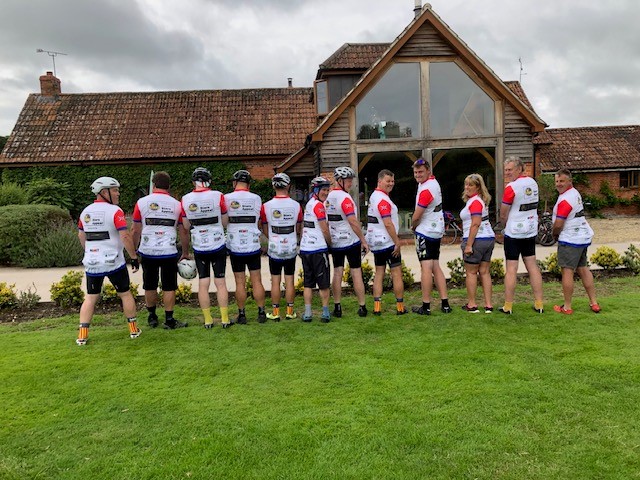William and his Unlikely Cyclists colleagues set off this morning at 9am sharp for their two-day trip to raise funds for the Salisbury Stars Appeal. Today they are heading to Axminster and tomorrow onto Mortonhampsted on the edge of Dartmoor. The total as at 13th July 11am stands at an amazing £25,355.
This is the full press release:
Team saddle up for cycle challenge from Wiltshire to Devon to support the Stars Appeal
11/07/23
A group of intrepid cyclists are saddling up for a journey of over 100 miles from Wiltshire to Devon for the Stars Appeal, Salisbury District Hospital’s Charity.
William Warden, of Conservation Contractors in Devizes, with his friends John Matthews, Andy Hillier, Matt Oakes, Mike and Elaine Davis, Nick Cordel, Matt Hurley, Alistair Fenwick, Wayne Davis, Tristan Warden and Chris Combe, have come together to form The Unlikely Cyclists. They have raised over £21,000 already.
The group, whose ages range from under 30 to over 70, will set off from Marston near Devizes on Thursday morning (July 13) where they will head to Axminster and then onto Mortonhampsted on the edge of Dartmoor.
William was inspired to take on the fundraising challenge after his wife Sarah was diagnosed with breast cancer last year. She was treated at the Salisbury District Hospital Breast Unit, which was funded by donations to the Stars Appeal.
He said: “I was sitting in the Breast Unit with my wife, Sarah, one damp and dark winter’s day. They have a list of people there who have raised or donated money to get the unit there and I felt I would like to do something to help. Whilst sitting there on my own, I had a “Eureka moment” – a group of friends are all going to Devon in July for a clay shoot and I will cycle there and raise a few pounds on the way.
“Having told everyone who was joining me in Devon my plan, most thought I was bonkers but, as time went by, a few hardy souls said they would like to try and do it as well. Thus “The Unlikely Cyclists” were born. As with these things, it has gathered pace, which has spurred everyone along.”
“Raising money for a local hospital and cancer treatment must be one of the most gratifying causes as we all get older and there are several health battles going on within the team, but this seems only to drive everyone a little harder,” he added.
The Stars Appeal funds projects across Salisbury Hospital which offer direct, practical support to patients, their families, and the Hospital’s staff. The charity has provided the Hospital with additional CT and MRI scanners. Donations also help fund projects supporting cancer patients, including free aromatherapy, headwear for patients who lose their hair, free drinks for chemotherapy and oncology outpatients, and a prehabilitation programme offering one-to-one support to help patients prepare for surgery and treatment.
The Unlikely Cyclists’ challenge is expected to take place over two days.
William said: “We all agree it will be hard work but, broken down over two days, we will all support each other along the way. The uphill part from Exeter to Dartmoor will be a hard slog on day two.”
His wife Sarah added: “Seeing “The Unlikely Cyclists “peddling off on training runs and coming back slightly less exhausted each week leaves me very humbled that they are prepared to give up their time, which we all are short of, to help raise funds.”
Helena Sinclair, of the Stars Appeal, said: “We want to wish William and the Unlikely Cyclists the best of luck with their cycling challenge. They have raised an incredible amount so far which will support projects making a difference to patients at Salisbury Hospital.”
To make a donation visit https://www.justgiving.com/page/william-warden-1684681401327




